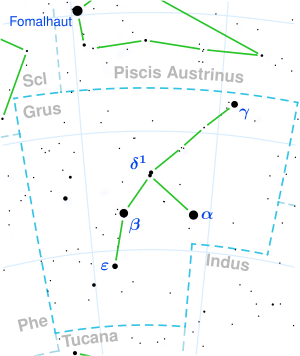Location of Gliese 832 in the constellation Grus | |
| Observation data Epoch J2000.0 Equinox J2000.0 | |
|---|---|
| Constellation | Grus |
| Right ascension | 21h 33m 33.97512s[1] |
| Declination | −49° 00′ 32.3994″[1] |
| Apparent magnitude (V) | 8.66[2] |
| Characteristics | |
| Evolutionary stage | main-sequence star |
| Spectral type | M2V[3] |
| B−V color index | 1.52[2] |
| Astrometry | |
| Radial velocity (Rv) | 12.72±0.13[1] km/s |
| Proper motion (μ) | RA: −45.917 mas/yr[1] Dec.: −816.875 mas/yr[1] |
| Parallax (π) | 201.3252 ± 0.0237 mas[1] |
| Distance | 16.200 ± 0.002 ly (4.9671 ± 0.0006 pc) |
| Absolute magnitude (MV) | 10.19[2] |
| Details | |
| Mass | 0.441 ± 0.011[4] M☉ |
| Radius | 0.442 ± 0.018[4] R☉ |
| Luminosity (bolometric) | 0.0276 ± 0.0009 [4] L☉ |
| Luminosity (visual, LV) | 0.007[note 1] L☉ |
| Surface gravity (log g) | 4.7[2] cgs |
| Temperature | 3,539+79 −74[4] K |
| Metallicity [Fe/H] | −0.06 ± 0.04[5] dex |
| Rotation | 37.5+1.4 −1.5 d[6] |
| Age | 6±1.5[6] Gyr |
| Other designations | |
| Database references | |
| SIMBAD | The star |
| planet c | |
| planet b | |
| Exoplanet Archive | data |
| Data sources: | |
| Hipparcos Catalogue, HD | |
Gliese 832 (Gl 832 or GJ 832) is a red dwarf of spectral type M2V in the southern constellation Grus.[8] The apparent visual magnitude of 8.66[2] means that it is too faint to be seen with the naked eye. It is located relatively close to the Sun, at a distance of 16.2 light years[1] and has a high proper motion of 818.16 milliarcseconds per year.[1] Gliese 832 has just under half the mass and radius of the Sun.[8] Its estimated rotation period is a relatively leisurely 46 days.[3] The star is roughly 6 billion years old.[6]
This star achieved perihelion some 52,920 years ago when it came within an estimated 15.71 ly (4.817 pc) of the Sun.[9]
Gliese 832 emits X-rays.[10] Despite the strong flare activity, Gliese 832 is producing on average less ionizing radiation than the Sun. Only at extremely short radiation wavelengths (<50nm) does its radiation intensity rise above the level of quiet Sun, but does not reach levels typical for active Sun.[11]
- ^ a b c d e f g Cite error: The named reference
GaiaDR3was invoked but never defined (see the help page). - ^ a b c d e Cite error: The named reference
bailey08was invoked but never defined (see the help page). - ^ a b Cite error: The named reference
mnras452_3_2745was invoked but never defined (see the help page). - ^ a b c d Cite error: The named reference
Pineda2021was invoked but never defined (see the help page). - ^ Cite error: The named reference
Lindgren2017was invoked but never defined (see the help page). - ^ a b c Cite error: The named reference
Gorrini2022was invoked but never defined (see the help page). - ^ Cite error: The named reference
Simbadwas invoked but never defined (see the help page). - ^ a b Cite error: The named reference
Mike Wallwas invoked but never defined (see the help page). - ^ Cite error: The named reference
aa575_A35was invoked but never defined (see the help page). - ^ Cite error: The named reference
Schmittwas invoked but never defined (see the help page). - ^ Fontenla, J. M.; Linsky, Jeffrey L.; Garrison, Jesse; France, Kevin; Buccino, A.; Mauas, Pablo; Vietes, Mariela; Walkowicz, Lucianne M. (2016). "Semi-Empirical Modeling of the Photosphere, Chromopshere, Transition Region, and Corona of the M-Dwarf Host Star Gj 832". The Astrophysical Journal. 830 (2): 154. arXiv:1608.00934. Bibcode:2016ApJ...830..154F. doi:10.3847/0004-637X/830/2/154. hdl:11336/21732. S2CID 119279568.
Cite error: There are <ref group=note> tags on this page, but the references will not show without a {{reflist|group=note}} template (see the help page).
